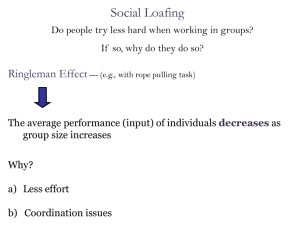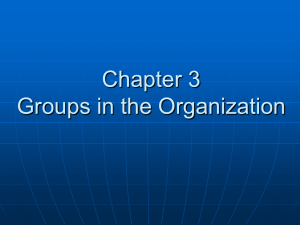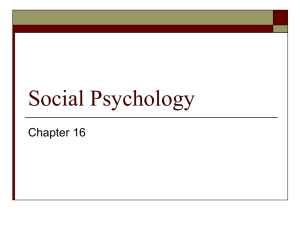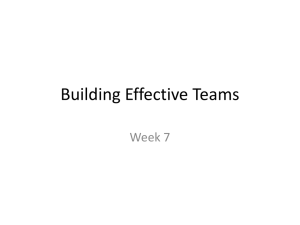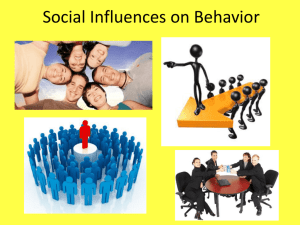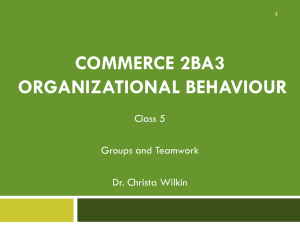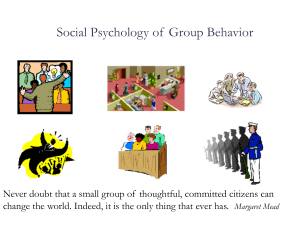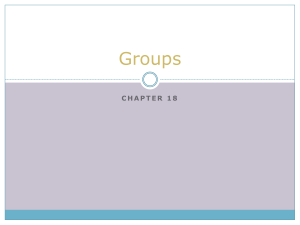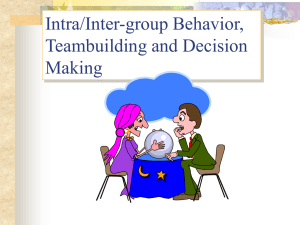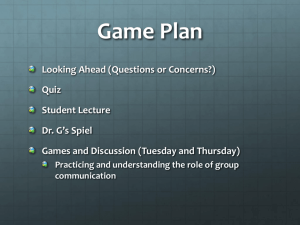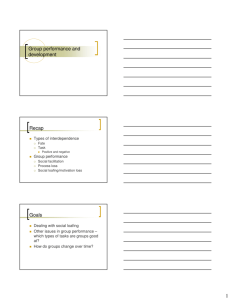Chapter 8 - Group Dynamics and Teamwork
advertisement
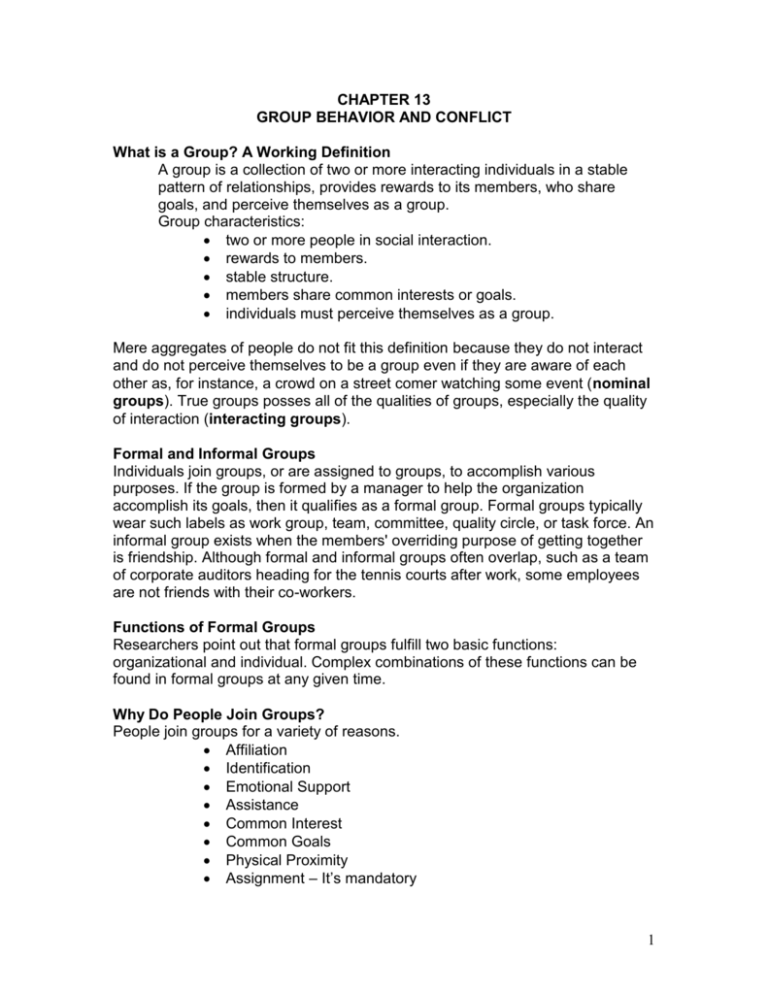
CHAPTER 13 GROUP BEHAVIOR AND CONFLICT What is a Group? A Working Definition A group is a collection of two or more interacting individuals in a stable pattern of relationships, provides rewards to its members, who share goals, and perceive themselves as a group. Group characteristics: two or more people in social interaction. rewards to members. stable structure. members share common interests or goals. individuals must perceive themselves as a group. Mere aggregates of people do not fit this definition because they do not interact and do not perceive themselves to be a group even if they are aware of each other as, for instance, a crowd on a street comer watching some event (nominal groups). True groups posses all of the qualities of groups, especially the quality of interaction (interacting groups). Formal and Informal Groups Individuals join groups, or are assigned to groups, to accomplish various purposes. If the group is formed by a manager to help the organization accomplish its goals, then it qualifies as a formal group. Formal groups typically wear such labels as work group, team, committee, quality circle, or task force. An informal group exists when the members' overriding purpose of getting together is friendship. Although formal and informal groups often overlap, such as a team of corporate auditors heading for the tennis courts after work, some employees are not friends with their co-workers. Functions of Formal Groups Researchers point out that formal groups fulfill two basic functions: organizational and individual. Complex combinations of these functions can be found in formal groups at any given time. Why Do People Join Groups? People join groups for a variety of reasons. Affiliation Identification Emotional Support Assistance Common Interest Common Goals Physical Proximity Assignment – It’s mandatory 1 Factors Affecting Group Performance Cohesiveness is the strength of group members' desires to remain a part of their groups. Cohesion is strengthened by: homogeneity the severity of the initiation to join the group. a high external threat or competition. the amount of time spent together. the smallness of the group. the group's history of success. Group cohesion has some important consequences as well: Positive people enjoy membership. members participate more fully. they tend to be highly productive. they experience low turnover. Negative groupthink arises when groups are too cohesive. group commitment might hinder productivity. groups may conspire to sabotage employers for the group's benefit. Group Size (Separate Discussion than Cohesiveness) How many group members is too many? The answer to this deceptively simple question has intrigued managers and academics for years. Folk wisdom says "two heads are better than one" but that "too many cooks spoil the broth." So where should a manager draw the line when staffing a committee? At 3? At 5 or 6? At 10 or more? Researchers have taken two different approaches to pinpointing optimum group size: mathematical modeling and laboratory simulations. Let us briefly review recent findings from these two approaches. Communication Structure see figure 13.02 page 509 Task versus Maintenance Roles Task roles enable the work group to define, clarify, and pursue a common purpose. Meanwhile, maintenance roles foster supportive and constructive interpersonal relationships. In short, task roles keep the group on track while maintenance roles keep the group together. A fraternity or sorority member is performing a task function when he or she stands at a business meeting and says: "What is the real issue here? We don't seem to be getting anywhere." Another individual who says, "Let's hear from those who oppose this plan," is performing a maintenance function. Importantly, each of the various task and maintenance roles may be played in varying combinations and sequences by either the group's leader or any of its members. 2 Presence of Others - when someone performs differently, either more effectively or less effectively, in the presence of others than when alone, they are experiencing social facilitation. This phenomenon is explained by several psychological processes. Individuals experience heightened emotional arousal. Then when aroused they have a tendency to perform the most dominant response, what comes normally. If the dominant response is appropriate, performance will be enhanced. If the dominant response is inappropriate, as in a new situation, performance will be impaired. While there is a lot of research to support this theory, the "why" of it is still unclear. Social facilitation may result in evaluation apprehension, the fear of being evaluated or judged by another. Another explanation is the distractionconflict model which recognizes that the presence of others creates a conflict as to where attention is directed. Social Loafing: "Free Riding" When Working with Others Additive tasks are those in which each person's contributions are added together to another's. Unfortunately, as people work together, some in the group may ride on the efforts of others. This is social loafing. Some explain social loafing through social impact theory, that the impact of any social force acting on a group is divided equally among its members. As a result, each member feels less than fully responsible for the outcome and puts in less effort. Another explanation is that the contributions of others makes each individual feel that his/her contribution is less important. A contributing issue is that some members of a group may be more interested in getting something for themselves than getting something for the group. Tips for eliminating social loafing Make each performer identifiable. Make work tasks more important and interesting . Reward individuals for contributing to their group's performance. Use punishment threats. Group Dominance Groupthink – coined by Irving Janis, groupthink refers to the tendency of cohesive groups to make bad decisions due to a failure to consider alternative points of view. Actual events that could be explained by this phenomenon include: 3 The Bay of Pigs Escalation of Troops in the Vietnam War The Challenger Launch Decision The Introduction of “New Coke” Tips for eliminating groupthink Devils Advocate Break up Groups Give Groups a Second Chance – Reinforce the idea that it’s alright to make mistakes. Group Conflict Conflict is a problem that occurs at several levels: between organizations; between groups; between members within groups; within an individual and between the multiple roles of a person's life. (interorganizational, intergroup, interpersonal; intrapersonal and interrole. Causes of Conflict Competition for Resources Task Interdependence Ambiguity Communication Barriers Personality Individual differences in how people deal with conflict. Five styles of handling conflict. Compromise - Split issues down the middle. Competition - high concern with one's own interests. Collaboration - high concern for one's own interest and those of others. Accommodation - giving others what they want. Avoidance - low concern for oneself and others. Effective Conflict Resolution Techniques: Bargaining Mediation Arbitration 4
